A Salvaged Banksy Mural is Now on View in NYC
This unique Banksy mural goes up for auction on May 21st in NYC!


Let’s be clear off the bat: the AMC show, TURN: Washington’s Spies, about the Culper Spy Ring that was based in Setauket, Long Island, is filmed in Richmond, Virginia. Given that Setauket has evolved from a small hamlet to a town of over 15,000, finding film locations that look 1776 bucolic are difficult. But, many of the homes and buildings referenced in the show are still standing, in this town that has always celebrated its history. These days, that sense of pride is heightened, with spy ring tours, new historic markers and Revolutionary War talks. In this article, we’ll compare and contrast the actual locations in the show with their cinematic counterparts in both Setauket and New York City.
Untapped Cities founder, Michelle Young, was born in Setauket and lived on Strong’s Neck (a name you’ll recognize if you watch the show). She tells us, “Looking back, it’s quite incredible to grow up in a town where history is all around you. The names Woodhull, Brewster and Strong are names I’ve known since childhood, as we learned tales of the spy ring. I can trace my love of history and architecture from growing up there. Coming full circle, a friend from growing up ended up being an extra in the first episode of the show.”

Photo: Antony Platt/AMC
During the Revolutionary War, British soldiers used the Setauket Presbyterian church as a stable, destroying its pulpit and interior. As shown in the show, tombstones from the cemetery were used as fortification by the British, though the role of Abraham Woodhull’s father, Judge Richard Woodhull as an appeaser of the British is fabricated. In real life he was beaten by the dreaded Colonel John Simcoe of the Queens Rangers, who has a role in the series, also slightly modified.
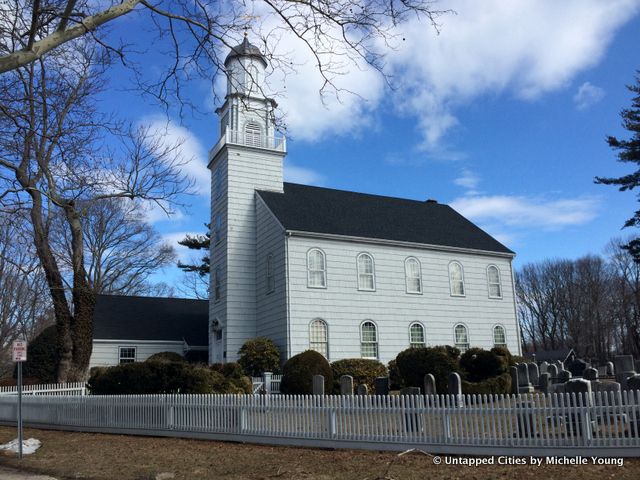
Setauket Presbyterian Church today
The Setauket Presbyterian church was led by Reverend Benjamin Tallmadge, father to Major Benjamin Tallmadge who was head of General Washington’s spy ring. Though damaged by bullets and canons during the war, the church stood until 1811 after which it was replaced by the current building.
Abraham Woodhull, childhood friend to Tallmadge and the key Setauket link of the spy ring, is buried in the cemetery here. A memorial around his tombstone was erected in 1936 by the Daughters of the American Revolution.

Abraham Woodhull grave and memorial
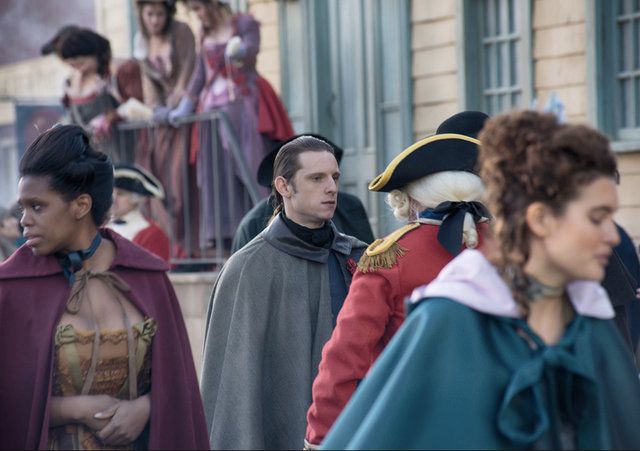
Photo: Antony Platt/AMC
New York City is shown several times in the television series, as it’s where Woodhull goes to scout out British military activity in the city. As correctly shown in the show, part of the colonial city was a hotbed for prostitution (above), while prisoners were held in prison ships, like the one in which Selah Strong was held captive (below). There were also numerous prisons on land converted from sugar factories, known as sugar prisons. Also shown in the show is the townhouse that serves as the headquarters for British Major John André, Kings College (later Columbia University), and many scenes of New York harbor.
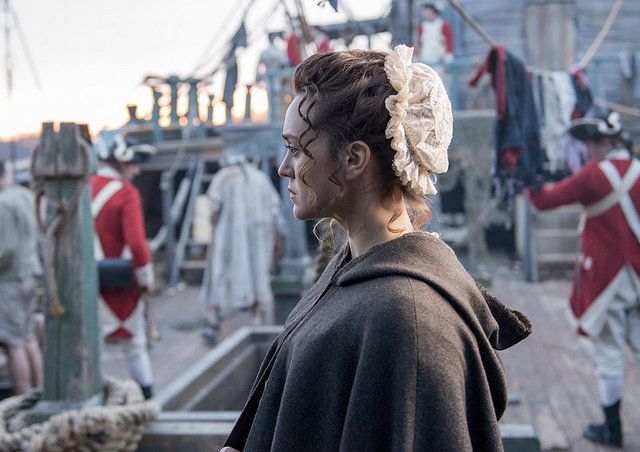
Aboard a British prison ship in New York harbor. Photo: Antony Platt/AMC

Not pictured in the show is the Caroline Church, just next to the Presbyterian Church. It’s an Anglican church that housed wounded Continental soldiers during the Battle of Setauket. Built in 1729, the building is still standing today, with bullet holes in the belfry that serve as a reminder of the fighting that took place. Services continued inside the Caroline Church during the war because it was Anglican, but not without incident–the reverend once interrupted his sermon to tell the British that their “damned Redcoats” were stealing potatoes from the church garden.
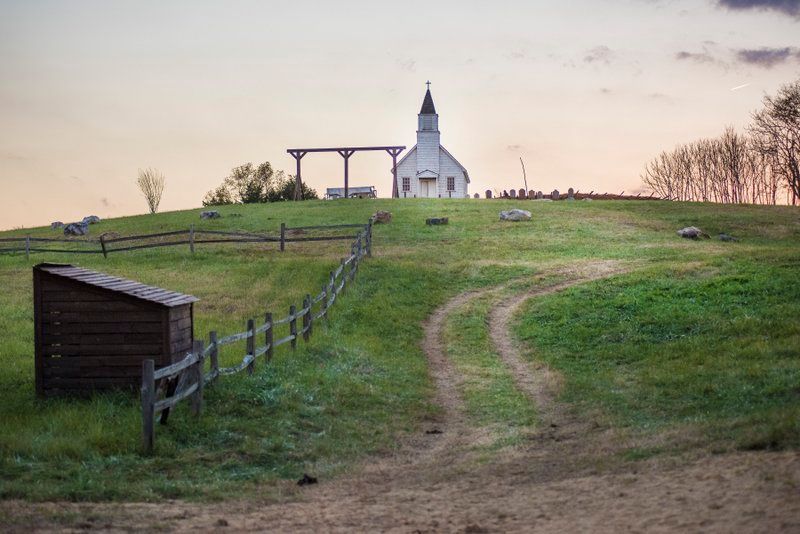
Photo: Antony Platt/AMC
Between the two churches is the Village Green, these days much smaller than it was during the war. The Battle of Setauket took place here, and the Continental Army attacked the British in the Presbyterian Church from a glacial boulder that is down the street on the left in the below photograph.

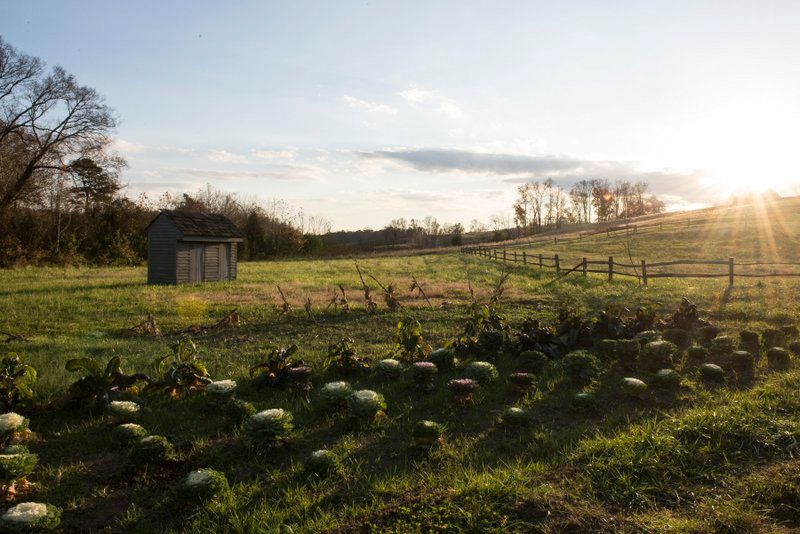
Photo: Antony Platt/AMC
Strong’s Neck plays a key role in the Culper Spy Ring. According to local folklore (and Strong family history), Anna Strong would hang a black petticoat from a clothesline as a signal to Abraham Woodhull when Caleb Brewster would arrive from Connecticut. Handkerchiefs also gave additional clues.
Unlike the film, Anna Strong didn’t live in Strong Manor during the war because of the solders quartered there, but lived in a small cottage on Little Bay across from Abraham Woodhull’s house. Woodhull’s house burned down in 1931, but its bricks were used to make his memorial at the Presbyterian Church. In the film, Woodhull’s house resembles the architecture of the Thompson House in Setauket (open for tours) rather than the more classic American style home it actually was–this choice is likely to make the home seem more like a farmstead.

Thompson House

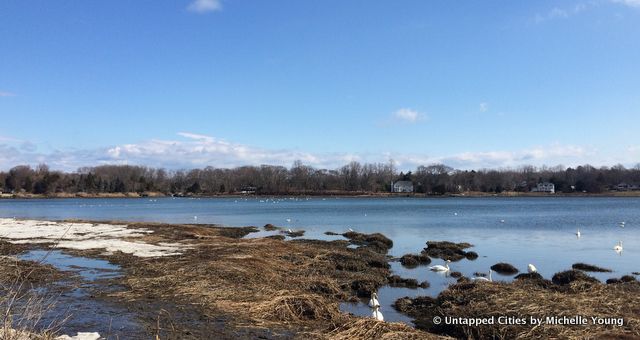
View of Smith-Strong Family Graveyard from Abraham Woodhull’s House
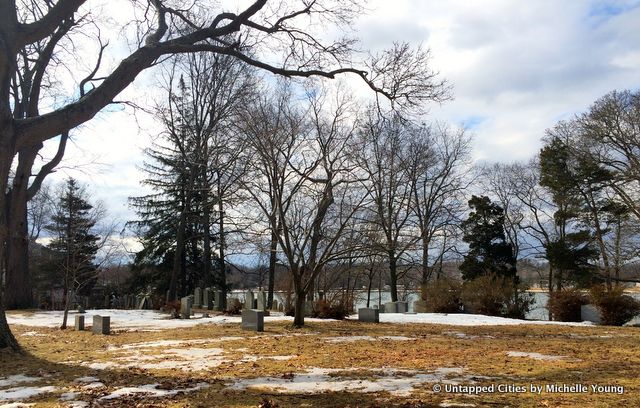
According to Alexander Rose’s book, Washington’s Spies: The Story of America’s First Spy Ring, on which the show TURN is based on, Anna Strong is only mentioned once in the Culper letters, designated as “the lady” and numbered 355 in the secret code. Anna accompanied Woodhull on one recorded trip to New York City, as the British were less likely to suspect and search “respectable married men traveling to see in-laws with their equally respectable wives.” This was done out of “sheer civility,” a concept probably quite foreign to spycraft today.
She was also a good friend of Caleb Brewster, the daring whaleboat captain who carried intelligence over Long Island Sound, also from Setauket. Anna was married to Selah Strong, who was (as the show depicts) jailed for being a suspected rebel.
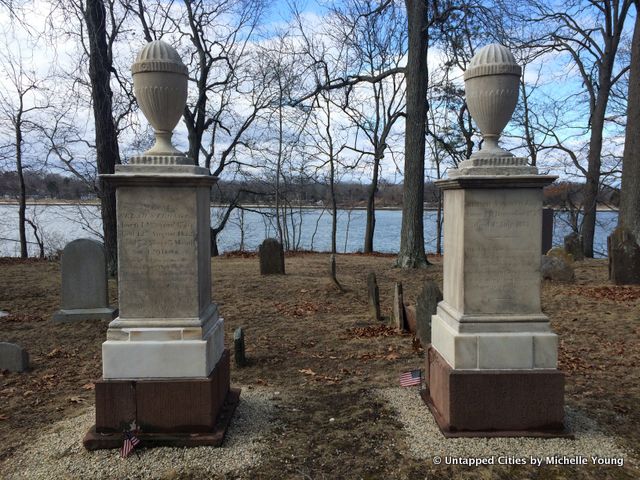
Tombstones of Anna and Selah Strong in the Smith-Strong Graveyard
The lack of references to Anna specifically in the letters do not necessarily indicate that her role has been exaggerated over the years, and likely it was to hide her identity. She stayed on in Strong’s Neck even after her husband’s release and relocation to Patriot-controlled Connecticut, and “appears to have stayed on the family estate to assist the Setauket Spies,” writes Beverly C. Tyler, historian at Three Village Historical Society. Her property is mentioned several times in the letters. A sign of her importance in the spy ring may be intimated by Washington’s visit to the Strong family following the war.

Well detailed in Washington Spies, spycraft was a burgeoning practice, and undercover spies were looked down upon as “beneath contempt,” working for pay and disguising themselves. The Culper Ring adamantly refused to work for pay, apart from reimbursements, and all of the members would keep their Revolutionary activities secret all the way to their graves. Even Benjamin Tallmadge, who later becomes a US Congressman, omits the spy activities from his autobiography referring to it merely as a “private correspondence with some persons in New York” that was “beneficial to the Commander-in-Chief”
In the television series, Woodhull and Anna were once betrothed and their work in the spy ring bring them closer together, and into an affair. In actuality, Anna was about a decade older than Woodhull and there is no evidence to suggest they were in any form of romantic relationship, as entertaining as it may be for modern day viewers.

Photo: Frank Ockenfels 3/AMC
In the show, Anna and Selah Strong own a tavern. In reality, they were more like landed gentry, with an estate and slaves. She was the daughter of a judge and Selah was a lawyer, graduated from Yale. There were several taverns in Setauket, and one in particular, has a tie to the Culpers. Roe Tavern was operated by Austin Roe, who was one of the messengers between Setauket and New York City. His job gave some credibility to the trips between Setauket and New York City.
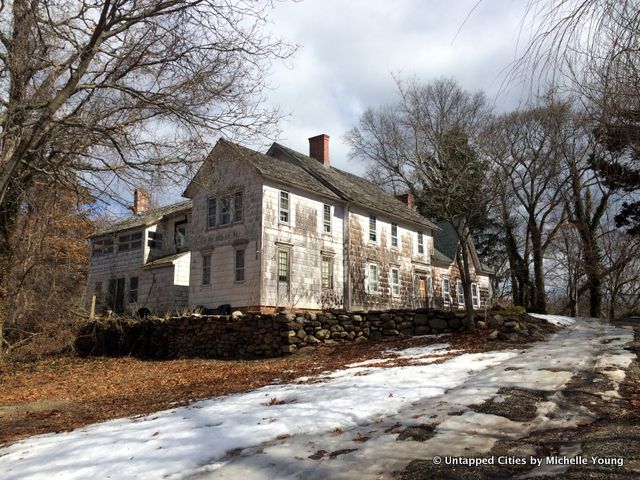
Roe Tavern
In 1790, President George Washington spent the night in Roe Tavern. The tavern was located on Main Street from 1703 to 1936, when it was moved to a private road about a mile away.


During the war, Jayne Tavern, also on Main Street but closer to the Village Green than Roe Tavern, was the site of a bloody massacre. The British came looking for deserters and opened fire, leaving four Americans dead. According to the Three Village Historical Society, bullet holes are still visible in the house, which is now private.
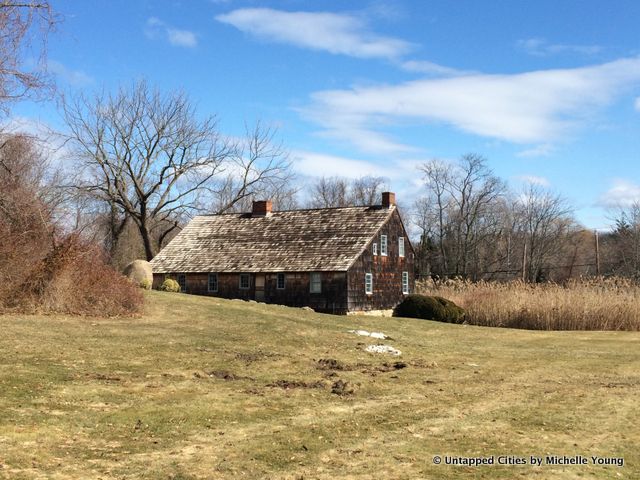
The Brewster House, which still stands on Main Street, was built around 1665, and was home to six generations of Brewsters. It was the home of Caleb Brewster’s cousin, Joseph Brewster who operated a tavern and store in the house during the American Revolution.
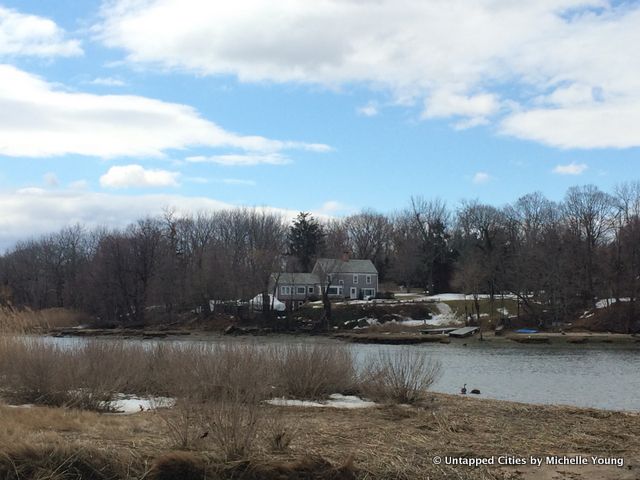
This was the home of Reverend Benjamin Tallmadge and his son, Major Benjamin Tallmadge, still a private home. Major Tallmadge is remembered as a sculpture on the facade of Setauket School and the actions of the Culper Spy Ring and the Battle of Setauket are memorialized in murals in the school auditorium.

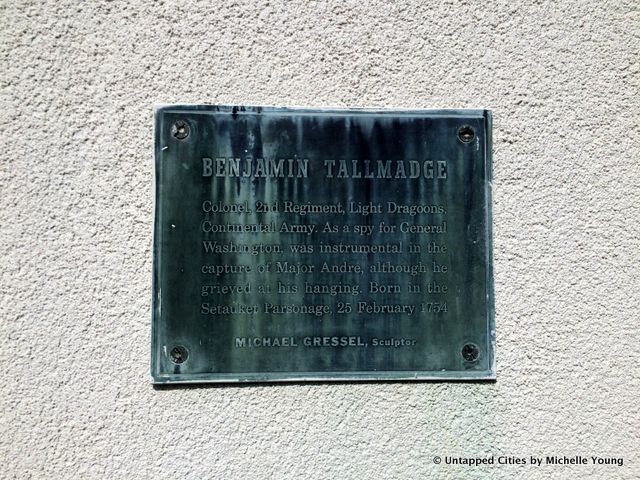
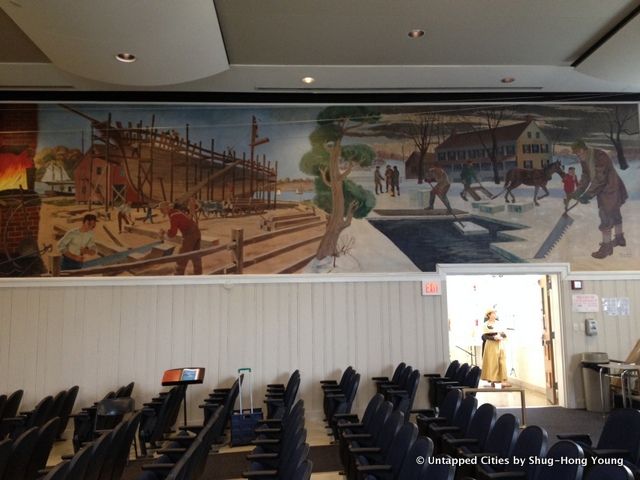
Murals inside Setauket School
For about another week, you can stream the entire first season of TURN on AMC. The second season premieres on April 13th. If you actually plan on visiting Setauket, the Emma S. Clark Memorial Library has a handy “Culper Spy Ring Map,” that you can pick up and the Three Village Historical Society has an exhibit called SPIES!. Finally, Setauket has some other claim to fames: home to Mick Foley the WF wrestler and one-time base for the bands Blue Oyster Cult and Twisted Sister.
Check out more from our Film Locations series here.
Subscribe to our newsletter